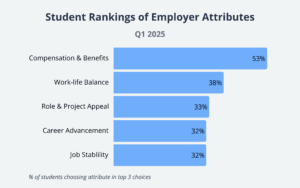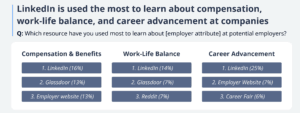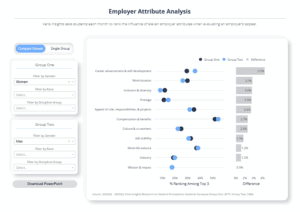June 13, 2025
How to Measure the Effectiveness of Your Employer Brand
How do you know if your employer brand is effective in attracting your ideal talent?
It’s one thing to craft a compelling message about your workplace. It’s another to know whether it’s reaching the right candidates and influencing their decisions. For Early Career talent, what you say about your company needs to reflect what they care about most. You also need a clear way to measure whether that message is resonating in the places they are most likely to look.
First Off, What do Students Actually Care About?
Value alignment matters to students. To stand out from the competition, focus on employer attributes that matter most to Gen Z. As of Q1 2025, in a Veris Insights survey of over 14,000 students, the top five values most frequently ranked in students’ top 3 employer attributes were:

How Candidates Research What They Care About
Most students spend 30 minutes or less researching each employer. With limited attention from targeted students, it’s important to understand where students go to learn about you, especially when evaluating the attributes they care about most.
Here are the resources students use to assess the top 3 employer attributes.

The takeaway? LinkedIn, Glassdoor, and your website are key channels for influencing employer brand perception. Prioritize these platforms in your employer brand strategy, and make sure your metrics track their impact.
Key Metrics for Tracking Your Employer Brand
Internal Brand Health Metrics
Strong employer brands don’t just attract talent, they retain it. Tracking internal brand metrics helps teams understand how well their employer brand resonates with current employees and recent hires. Here are some key metrics to monitor:
- New Hire Retention Rate: A high retention rate among new hires indicates that expectations set during the hiring process align with the actual employee experience, an essential sign of brand consistency.
- Employee Engagement: Tools like employee engagement surveys reveal how likely employees are to stay, thrive, and recommend your company as a great workplace.
- Internal Advocacy & Referrals: When employees actively promote your company or refer candidates, it’s a strong indicator of trust in the employer brand. Track referral rates and employee-generated content on platforms like LinkedIn.
- Cost Per Hire: Efficient hiring processes supported by a strong employer brand can reduce recruitment costs. Monitoring the cost per hire can help tie employer branding efforts to budget impact.
- Quality of Hire: Evaluate how well new employees perform, engage, and grow. Strong quality-of-hire scores often reflect a brand that attracts the right talent.
- Offer Acceptance Rate: A high acceptance rate suggests that your value proposition and what candidates believe they’ll get from working at your company match what you’re offering.
- Renege Rate: Candidates backing out after signing an offer can signal a disconnect between perceived and actual employer brand. A rising renege rate is worth a closer look.
By tracking these internal employer brand metrics, you can better understand what’s working and where expectations are misaligned. All in all, the goal is to use these to build a more consistent and compelling employee experience.
External Brand Health Metrics
Student data indicates that LinkedIn and Glassdoor are primary resources for evaluating top employer attributes, including compensation, work-life balance, and career advancement opportunities. This provides a case to not only show up on these platforms, but to track how your brand is performing there.
- Social Engagement on LinkedIn: With a quarter of students using LinkedIn to evaluate the career advancement potential of an employer brand, your presence on the platform matters. Monitor engagement metrics such as likes, comments, shares, and follower growth to assess how effectively your content resonates with Early Career talent.
- Glassdoor Reviews & Ratings: Students are also turning to Glassdoor to evaluate compensation and work-life balance. Tracking your company’s rating, review volume, and the sentiment of recent feedback can reveal how your internal culture is perceived externally. Consistent positive reviews support brand trust and help convert curious candidates into applicants.
These metrics don’t just offer feedback, they connect directly to the platforms students rely on most when deciding where to apply. Incorporating them into your employer brand strategy ensures your team is measuring impact where it matters most.
Measuring the ROI of Employer Branding
A strong employer brand doesn’t just attract talent, it also reduces hiring costs and improves retention. In a competitive talent market, it’s one of the most strategic investments your team can make.
However, like any investment, leadership wants to know: Is it worth it? How do we prove its value?
Measuring the ROI of employer branding means connecting brand health to tangible outcomes like:
- Faster time-to-fill
- Lower cost per hire
- Higher quality of hire
- Increased offer acceptance rates
- Stronger employee retention
When your employer brand is doing its job, you spend less time convincing candidates to join and more time choosing the right ones. You may also reduce reneges and see greater returns from every recruiting dollar spent.
To calculate ROI, compare performance before and after brand investments:
- Are candidates moving through the funnel faster?
- Are referrals up?
- Are hiring managers more satisfied with new hires?
These are signs your employer brand is working and worth continued investment.
See how KPMG used employer brand analysis to improve student perception.
Using Research Analytics and Data to Make Informed Employer Brand Decisions
Measuring employer brand impact is easier with the right data. Tools like Veris Insights’ Employer Attribute Explorer provide valuable data around student preferences. This interactive tool lets you gauge how students across different majors and demographic groups rate key employer attributes, both now and over time.

A strong employer brand influences key outcomes like offer acceptance and retention. For Early Career talent, especially, alignment with values like compensation, work-life balance, and growth potential goes a long way.
By focusing your strategy on channels students trust most, like LinkedIn, Glassdoor, and your careers site, along with tracking meaningful internal and external metrics, you can ensure your brand is resonating where it counts. With the right data and tools in place, your employer brand becomes a measurable, strategic advantage.
